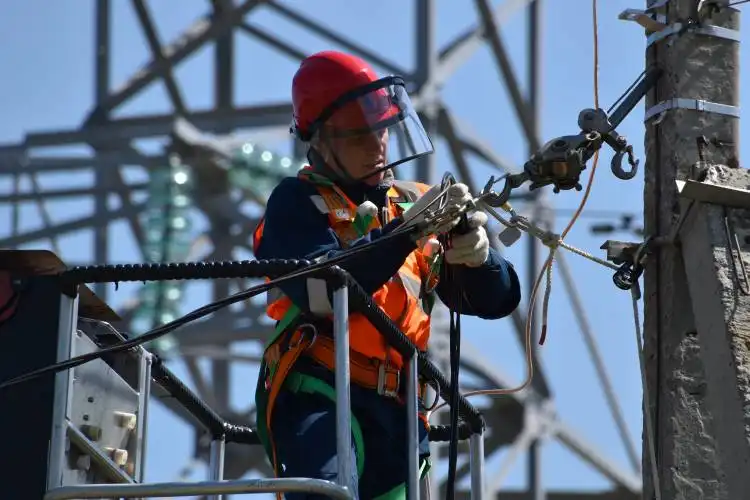Start a Poison Ivy Removal Business
Harness Your Inner Green-Thumb Superhero: The Unexpected Lucrativeness of a Poison Ivy Removal Business
| Updated


POISON IVY REMOVAL BUSINESS
Venture into the unexpected, yet promising business world of Poison Ivy Removal! This audacious start-up will have you decked out in protective gear, rescuing hapless homeowners from the tenacious grasp of poison ivy in their backyards. The business mainly involves identifying, clearing, and safely disposing of the notorious tri-leaved menace, which can be a lucrative business especially during spring and summer times. Unleash your inner superhero and remember - not all heroes wear capes, some wield gardening sheers!
Jump to Business Plan
RELATED BUSINESS IDEAS
Browse ALL Home Improvement & Repair Solutions Business Ideas
Discover Your Perfect Domain
Unlock the door to your online success with our hand-picked selection of premium domain names. Whether you're starting a new venture or rebranding an existing one, the right domain can set the tone for your digital presence. Browse through our curated list, each with its unique potential to enhance your brand's visibility and credibility.
POISON IVY REMOVAL MINI BUSINESS PLAN
This a quick reality check to help you identify the strengths and weaknesses of your business concept before you dive in.
Expected Percent Margin:
- Gross Margin: 70-80%
- Net Profit Margin: 20-30%
Earnings Expectations:
- Daily Earnings: $500 - $1000
- Weekly Earnings: $2,500 - $5,000
- Monthly Earnings: $10,000 - $20,000
- Annual Earnings: $120,000 - $240,000
Actions to Hit Those Numbers:
Service Quality:
- Training: Ensure all staff are trained in safe and effective poison ivy removal techniques, including the correct use of PPE.
- Tools: Invest in good quality tools and protective clothing for staff.
Marketing & Client Acquisition:
- Online & Offline Marketing: Enhance your online presence via SEO optimized website, social media platforms and offline via leaflets, local news ads, and partnerships with local businesses.
- Networking: Build a solid network to get referrals from lawn care services, real estate agents, and property managers
Pricing & Service Offering:
- Pricing Strategy: Set competitive prices bear in mind the direct labor cost, equipment, insurances, and disposal fees.
- Service Offering: Offer both residential and commercial poison ivy removal services.
Cost Control:
- Equipment maintenance: Regular equipment maintenance must be done to avoid operational delays due to broken machinery.
- Waste Disposal: Proper waste management methods must be put in place to avoid any unnecessary costs or legal liabilities associated with poison ivy disposal.
Business Operations:
- Scheduling: Efficient schedule management to serve multiple clients in a day.
- Seasonality: Business will be highly seasonal, so financial planning should factor in busy and slow periods.
Please note: These are generalized estimations and can vary depending on region, economic conditions, and individual business strategies. Always consult with a financial advisor for personalized advice.
NOT WHAT YOU HAD IN MIND? Here are more ideas



Browse ALL Home Improvement & Repair Solutions Business Ideas
Grab Your Business Website Name
Before you get caught up in the whirlwind of setting up your business, invest in a domain name. It's a small but significant step that lays the foundation for your brand and makes it easier for customers to find and trust you. Just like you wouldn't build a house without securing the land first, don't build a business without securing your domain name.
"Why? Can't that wait?" Here's why it shouldn't
Step 1: Determine if Poison Ivy Removal Business is Right for You
Breakdown of Startup Expenses
When starting a poison ivy removal business, there are several startup expenses to consider. These include the cost of equipment, such as a lawn mower, weed whacker, and other tools. Additionally, there may be costs associated with obtaining a business license, insurance, and any required permits. Furthermore, you may need to hire employees or subcontractors to help with the business. Finally, you may need to invest in marketing materials such as business cards, flyers, and a website.
Breakdown of Ongoing Expenses
Once the poison ivy removal business is up and running, there are ongoing expenses to consider. These include the cost of supplies such as herbicides, protective gear, and other materials. Additionally, you may need to pay for advertising or other marketing efforts. Furthermore, you may need to pay for any necessary repairs or maintenance to your equipment. Finally, you may need to pay for any necessary insurance or permits.
Examples of Ways to Make Money
When starting a poison ivy removal business, there are several ways to make money. One way is to charge a flat fee for each job. Additionally, you can charge a fee for each hour of work. Furthermore, you can charge a fee for each type of service you provide. Finally, you can offer additional services such as landscaping or lawn care, which can help you increase your profits.
Step 2: Name the Business
Tips for Choosing a Name
When choosing a name for a poison ivy removal business, it is important to pick something that is memorable and unique. Consider using a combination of words that are related to the services you provide, such as “Poison Ivy Solutions” or “Ivy Away.” Additionally, it is important to make sure the name is not already in use by another business. Research the name online and check with the Secretary of State to make sure the name is available.
Register the Business Name
Once you have chosen a name for your poison ivy removal business, you will need to register it with the Secretary of State. This process is relatively simple and involves filling out an application and paying a fee. Depending on the state, the fee may range from $50 to $200. Additionally, you may need to register the business with the county or city in which you plan to operate. This will require additional paperwork and fees. After registering the business name, you will receive a certificate of registration that you can use to open a business bank account and apply for business licenses and permits.
Step 3: Obtain Necessary Licenses and Permits
Research Local Regulations
Before starting a poison ivy removal business, it is important to research the local regulations and laws that govern the business. Depending on the location, there may be certain licenses and permits that are required in order to legally operate. For example, some states may require a pesticide license in order to use certain chemicals for removal. Additionally, some states may require a business license or permit in order to operate a business. It is important to research the local regulations and laws to ensure that the business is in compliance.
Obtain Necessary Licenses and Permits
Once the local regulations and laws have been researched, it is important to obtain the necessary licenses and permits. Depending on the location, this may involve submitting an application, paying a fee, and/or providing proof of insurance. Additionally, some states may require a background check in order to obtain certain licenses and permits. It is important to obtain the necessary licenses and permits in order to legally operate the business.
Step 4: Create a Business Plan
Outline Business Goals
When creating a business plan, it is important to outline your business goals. This should include what services you will offer, the target market you are aiming to serve, and the expected growth of the business. It is also important to consider the long-term goals of the business and how you plan to achieve them. Additionally, you should include a timeline of when you plan to reach each goal.
Describe Services Offered
In your business plan, you should also describe the services that you will offer. This should include the type of poison ivy removal services you will offer, such as removal of poison ivy from residential or commercial properties, as well as any additional services you may offer. Additionally, you should include any specializations you may have, such as organic or chemical-free removal methods.
Estimate Start-up Costs
When creating your business plan, it is important to estimate the start-up costs associated with your poison ivy removal business. This should include the cost of any equipment or supplies you may need, such as protective gear, herbicides, and tools. Additionally, you should include the cost of any licenses or permits you may need to operate your business. Finally, you should also include the cost of any marketing materials you may need to promote your business.
Step 5: Secure Financing
Research Potential Funding Sources
Before you can start your poison ivy removal business, you need to secure the necessary financing. Research potential funding sources such as banks, credit unions, and other financial institutions. You may also want to look into government grants and other funding opportunities. Make sure to compare interest rates, fees, and other terms of each potential source of financing.
Create a Financial Plan
Once you have identified potential funding sources, create a financial plan. This plan should include your estimated startup costs, ongoing expenses, and projected revenue. Make sure to include a detailed budget for each expense, such as equipment, supplies, and labor. You should also include a timeline for when you expect to break even and start making a profit. Additionally, include a contingency plan in case your business does not meet your financial expectations.
Step 6: Purchase Equipment and Supplies
Research Potential Vendors
Before making any purchases, it is important to research potential vendors to ensure that you are getting the best deal. Look for vendors that specialize in poison ivy removal supplies and compare prices and quality. Make sure to read reviews and ask for references to ensure that you are getting the best quality supplies for your business.
Compare Prices and Quality
Once you have identified potential vendors, it is important to compare prices and quality. Look for vendors that offer discounts or bulk pricing. Also, make sure to read reviews and ask for references to ensure that you are getting the best quality supplies for your business. Additionally, compare the quality of the supplies to make sure that you are getting the best value for your money.
Step 7: Market Your Business
Creating a website is a great way to market your poison ivy removal business. You can use a website to showcase your services, list your contact information, and provide potential customers with information about your business. You can also use the website to post customer reviews and testimonials, which can help to build trust with potential customers. Additionally, you can use the website to provide helpful tips and advice on how to prevent and treat poison ivy.
Social media is another great way to market your business. You can use social media to promote your services, share helpful information, and interact with potential customers. You can also use social media to post customer reviews and testimonials, which can help to build trust with potential customers. Additionally, you can use social media to share helpful tips and advice on how to prevent and treat poison ivy.
Networking with local businesses is another great way to market your poison ivy removal business. You can reach out to local landscaping companies, garden centers, and nurseries to let them know about your services. You can also reach out to local pest control companies and offer to partner with them on poison ivy removal projects. Additionally, you can reach out to local real estate agents and offer to provide poison ivy removal services for their clients.
Step 8: Hire Employees
Determine Staffing Needs
Before hiring any employees, it is important to determine the staffing needs of the business. This includes assessing the size of the business and the number of employees needed to meet the demands of the business. It is also important to consider the skills and experience that are needed to provide the best service to customers.
Create Job Descriptions
Once the staffing needs have been determined, it is important to create job descriptions for each position. This will help to ensure that the right people are hired for the job. Job descriptions should include a detailed description of the duties and responsibilities of each position, as well as any qualifications or experience that is required.
Recruit and Train Employees
After the job descriptions have been created, it is time to start recruiting and training employees. This can be done through job postings, online job boards, or by attending job fairs. Once the employees have been hired, it is important to provide them with the necessary training to ensure they are able to perform their duties. This can include on-the-job training, as well as classroom training. It is also important to provide ongoing training to ensure that employees are up to date on the latest techniques and safety protocols.
Step 9: Monitor Your Business
The final step in starting a poison ivy removal business is to monitor your business. This means tracking your revenue and expenses, evaluating your performance, and making adjustments as needed. To track your revenue and expenses, you should create a spreadsheet that lists all of your income and expenses. This will help you to identify areas where you are spending too much or not enough. You should also track your customer satisfaction ratings, so you can make sure your customers are happy with your services.
To evaluate your performance, you should review your financial statements and compare them to industry standards. This will help you to identify areas where you can improve your business. You should also review customer feedback to see if there are any areas where you can improve your services. Finally, you should review your marketing efforts to make sure you are reaching your target audience.
Once you have evaluated your performance, you should make any necessary adjustments. This could include changing your pricing structure, improving your customer service, or increasing your marketing efforts. You should also review your business plan to make sure it is still relevant and up-to-date.
Finally, you should regularly review your financial statements to make sure you are staying on track. This will help you to identify any potential problems before they become too serious. You should also review your customer feedback to make sure you are meeting their expectations. By monitoring your business, you can ensure that your poison ivy removal business is successful.
EXPLORE MORE CATEGORIES
Browse ALL Business Idea Categories
TAKE THE NEXT STEPS










